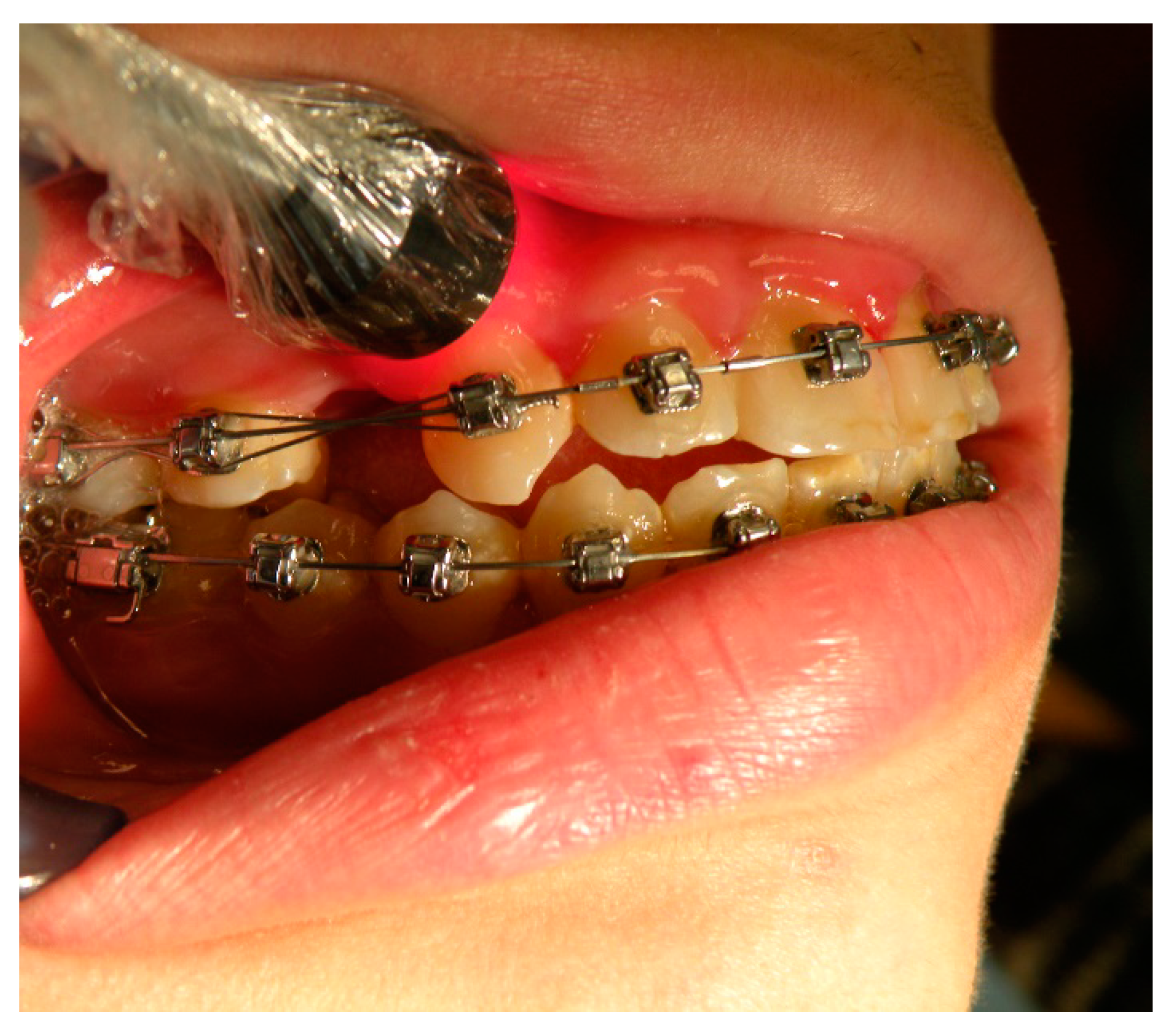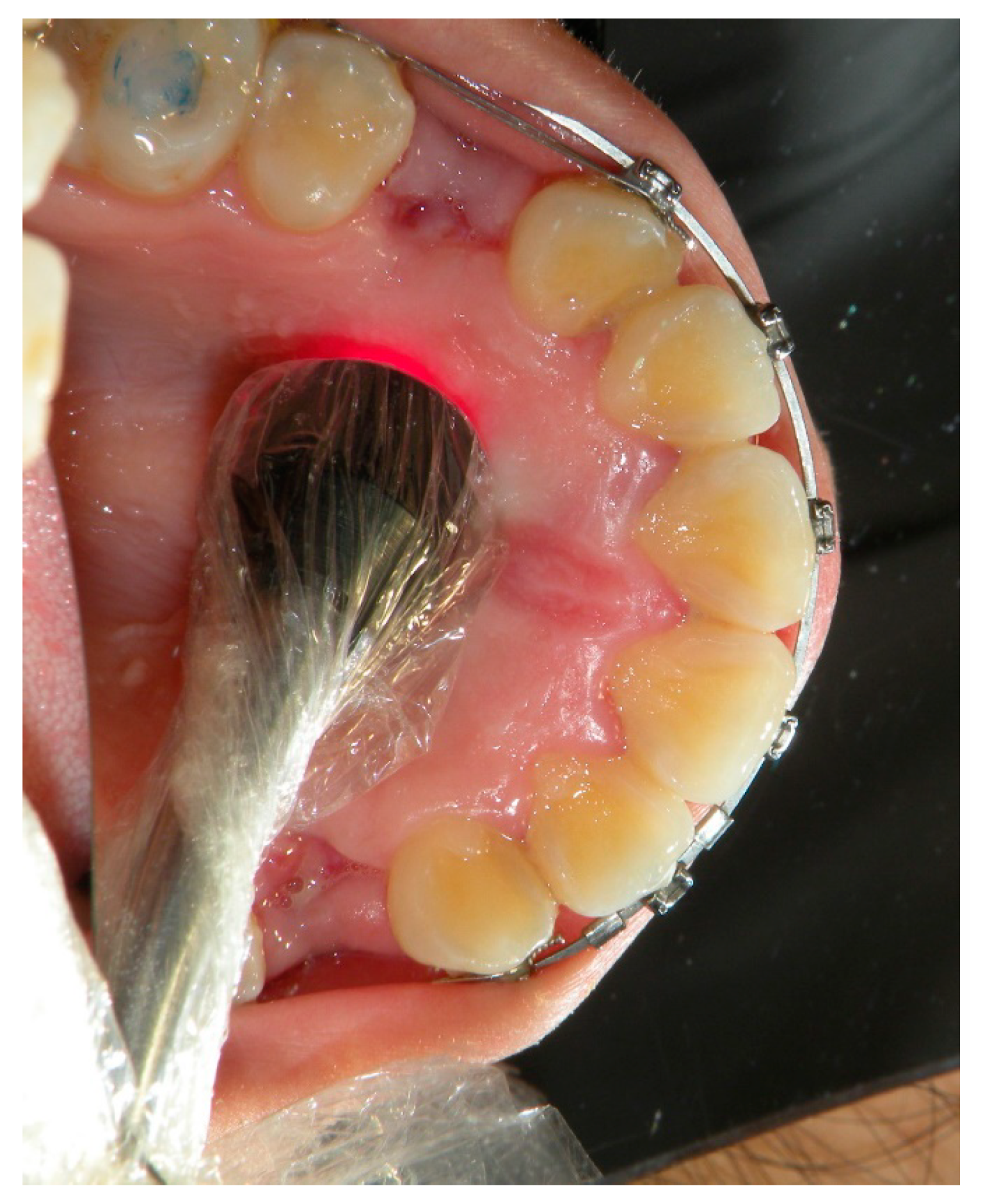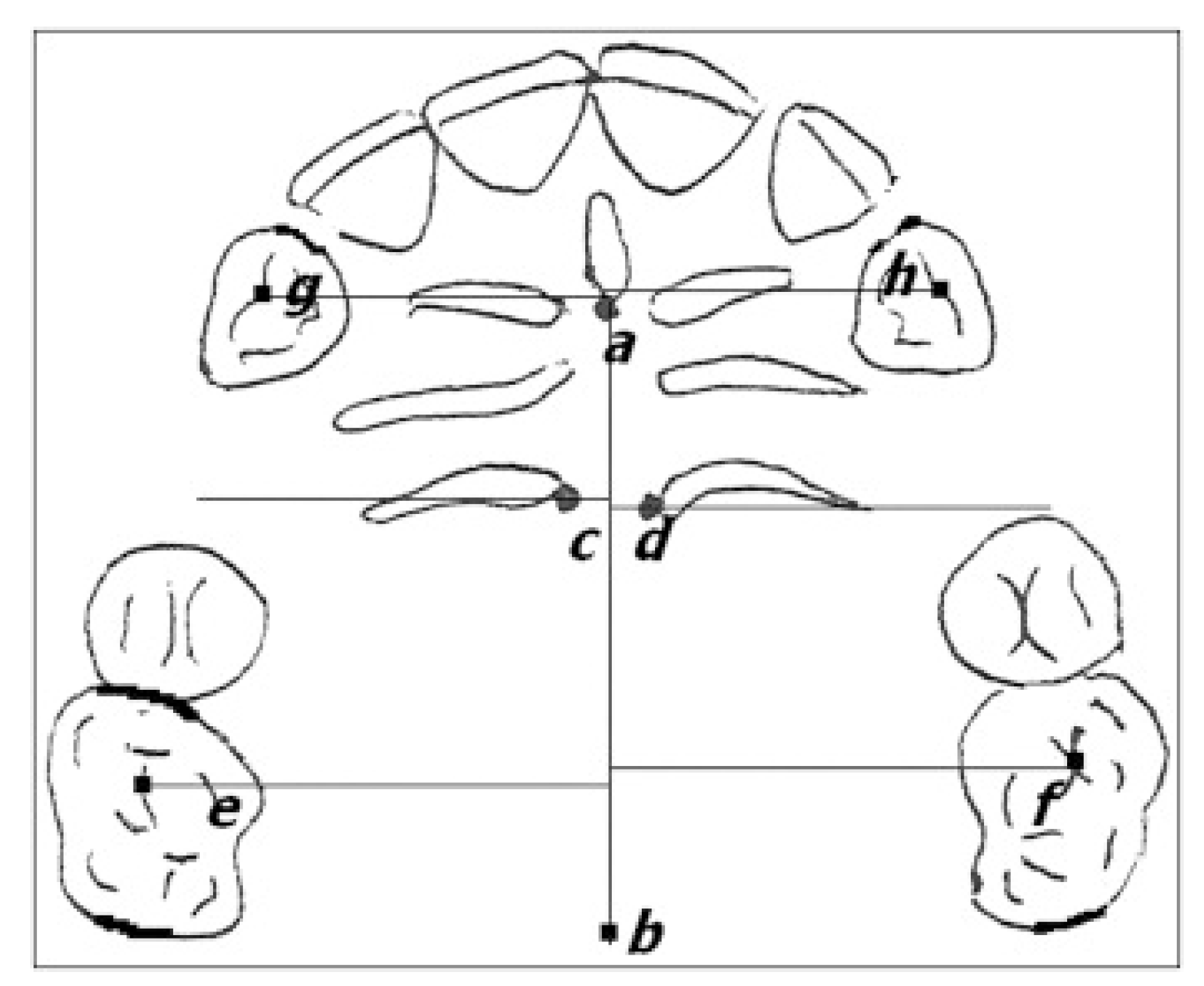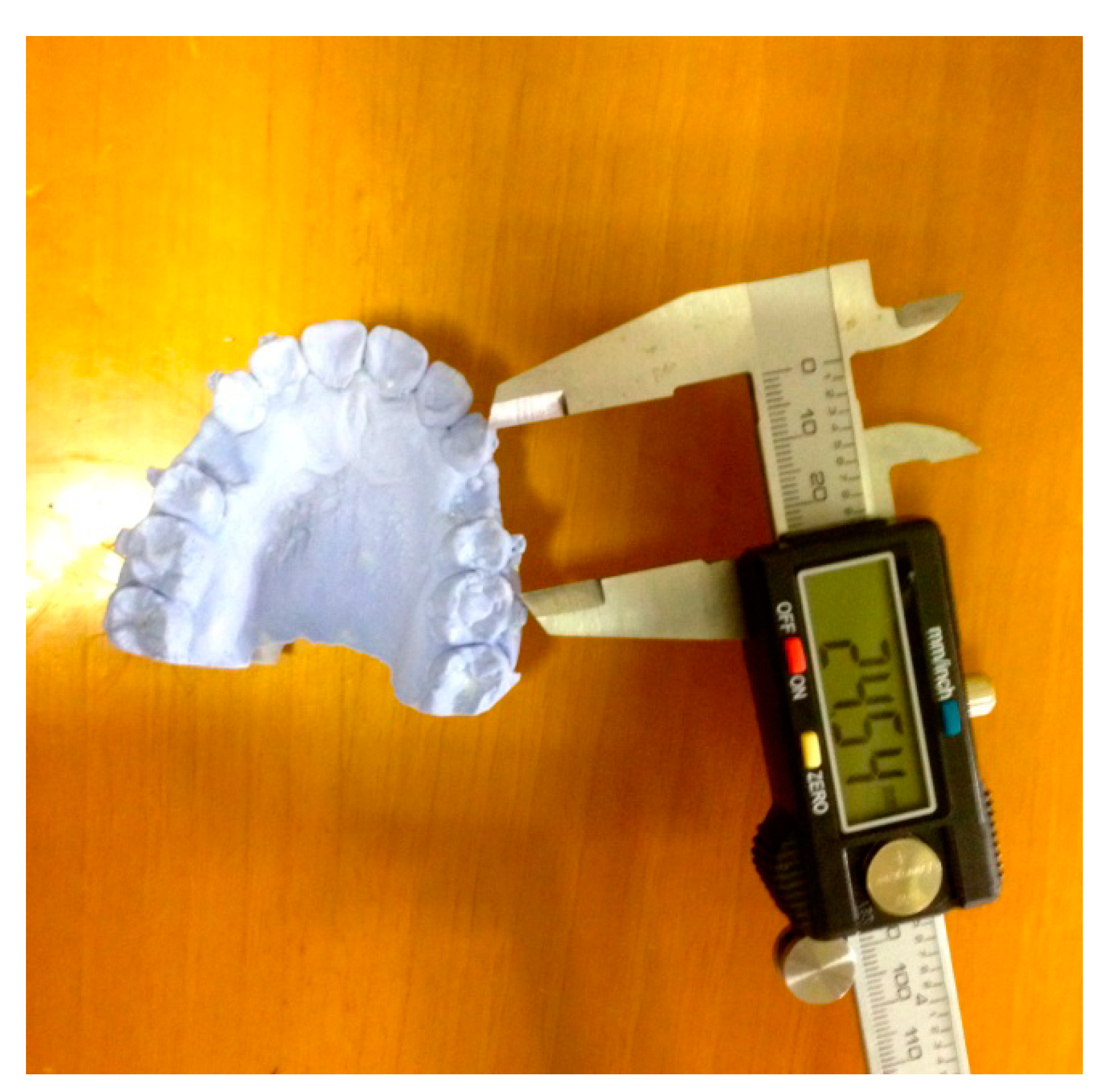Photobiomodulation Therapy on Orthodontic Movement: Analysis of Preliminary Studies with a New Protocol
Abstract
1. Introduction
2. Materials and Methods
2.1. Pilot Study Design
- -
- the need to extract the first upper and/or lower premolars to obtain the space necessary for the correct alignment of the arches or the distalization of the frontal sectors to restore correct antero-posterior occlusal positions (compensate for a class II or solve a bi-protrusion);
- -
- presence of canines, second premolars, and first permanent molars in the arch;
- -
- good periodontal health conditions;
- -
- good level of oral hygiene;
- -
- absence of systemic diseases or pharmacological treatments that could interfere with the orthodontic movement, such as the intake of analgesic or anti-inflammatory drugs.
2.1.1. Orthodontic Protocol
2.1.2. PBMT Protocol
2.2. Methods
- -
- the anterior–posterior position of the canines to obtain their retraction speed;
- -
- the anterior–posterior position of the first molars to evaluate the possible loss of anchorage of the posterior sector.
- -
- cusp of the canine;
- -
- mesio-vestibular cusp of the first molar;
- -
- median palatine raphe;
- -
- most medial point of the third palatine wrinkle (points C and D);
- -
- central fossa of the first molars (points E and F);
3. Results
4. Discussion
5. Conclusions
Author Contributions
Funding
Conflicts of Interest
References
- Fink, D.F.; Smith, R.J. The duration of orthodontic treatment. Am. J. Orthod. Dentofac. Orthop. 1992, 102, 45–51. [Google Scholar] [CrossRef]
- Skidmore, K.J.; Brook, K.J.; Thomson, W.M.; Harding, W.J. Factors influencing treatment time in orthodontic patients. Am. J. Orthod. Dentofac. Orthop. 2006, 129, 230–238. [Google Scholar] [CrossRef] [PubMed]
- Impellizzeri, A.; Putrino, A.; Zangrillo, C.; Barbato, E.; Galluccio, G. Efficiency of self-ligating vs conventional braces: Systematic review and meta-analysis. J. Dent. Cadmos 2019, 87, 347–356. [Google Scholar] [CrossRef]
- Segal, G.R.; Schiffman, P.H.; Tuncay, O.C. Meta analysis of the treatment-related factors of external apical root resorption. Orthod. Craniofacial Res. 2004, 7, 71–78. [Google Scholar] [CrossRef] [PubMed]
- Pandis, N.; Nasika, M.; Polychronopoulou, A.; Eliades, T. External apical root resorption in patients treated with conventional and self- ligating brackets. Am. J. Orthod. Dentofac. Orthop. 2008, 134, 646–651. [Google Scholar] [CrossRef]
- Impellizzeri, A.; Di Benedetto, S.; De Stefano, A.; Guercio, E.M.; Barbato, E.; Galluccio, G. General health & psychological distress in children with temporomandibular disorder. Case Report. Clin. Ter 2019, 170, e321–e327. [Google Scholar]
- Pomini, K.T.; Buchaim, D.V.; Andreo, J.C.; Rosso, M.P.D.O.; Della Coletta, B.B.; German, I.S.; Bighetti, A.; Shinohara, A.; Junior, G.M.R.; Shindo, J.; et al. Fibrin Sealant Derived from Human Plasma as a Scaffold for Bone Grafts Associated with Photobiomodulation Therapy. Int. J. Mol. Sci. 2019, 20, 1761. [Google Scholar] [CrossRef]
- Rosso, M.P.D.O.; Junior, G.M.R.; Buchaim, D.V.; German, I.J.S.; Pomini, K.T.; De Souza, R.G.; Pereira, M.; Júnior, I.A.F.; Bueno, C.R.D.S.; Gonçalves, J.B.D.O.; et al. Stimulation of morphofunctional repair of the facial nerve with photobiomodulation, using the end-to-side technique or a new heterologous fibrin sealant. J. Photochem. Photobiol. B: Boil. 2017, 175, 20–28. [Google Scholar] [CrossRef]
- Zein, R.; Selting, W.; Hamblin, M. Review of light parameters and photobiomodulation efficacy: Dive into complexity. J. Biomed. Opt. 2018, 23, 120901. [Google Scholar] [CrossRef]
- Collins, M.K.; Sinclair, P.M. The local use of vitamin D to increase the rate of orthodontic tooth movement. Am. J. Orthod. Dentofac. Orthop. 1988, 94, 278–284. [Google Scholar] [CrossRef]
- Seifi, M.; Eslami, B.; Saffar, A.S. The effect of prostaglandin E2 and calcium gluconate on orthodontic tooth movement and root resorption in rats. Eur. J. Orthod. 2003, 25, 199–204. [Google Scholar] [CrossRef] [PubMed]
- Kale, S.; Kocadereli, I.; Atilla, P.; Asan, E. Comparison of the effects of 1,25 dihydroxycholecalciferol and prostaglandin E2 on orthodontic tooth movement. Am. J. Orthod. Dentofac. Orthop. 2004, 125, 607–614. [Google Scholar] [CrossRef] [PubMed]
- Soma, S.; Matsumoto, S.; Higuchi, Y.; Takano-Yamamoto, T.; Yamashita, K.; Kurisu, K.; Iwamoto, M. Local and chronic application of PTH accelerates tooth movement in rats. J. Dent. Res. 2000, 79, 1717–1724. [Google Scholar] [CrossRef] [PubMed]
- Liu, Z.J.; King, G.J.; Gu, G.M.; Shin, J.Y.; Stewart, D.R. Does Human Relaxin Accelerate Orthodontic Tooth Movement in Rats? Ann. N. Y. Acad. Sci. 2005, 1041, 388–394. [Google Scholar] [CrossRef] [PubMed]
- Ren, A.; Lv, T.; Kang, N.; Zhao, B.; Chen, Y.; Bai, D. Rapid orthodontic tooth movement aided by alveolar surgery in beagles. Am. J. Orthod. Dentofac. Orthop. 2007, 131, 160.e1–160.e10. [Google Scholar] [CrossRef] [PubMed]
- Liou, E.J.; Huang, C. Rapid canine retraction through distraction of the periodontal ligament. Am. J. Orthod. Dentofac. Orthop. 1998, 114, 372–382. [Google Scholar] [CrossRef]
- Wang, L.; Lee, W.; Lei, D.-L.; Liu, Y.-P.; Yamashita, D.-D.; Yen, S. Tisssue responses in corticotomy- and osteotomy-assisted tooth movements in rats: Histology and immunostaining. Am. J. Orthod. Dentofac. Orthop. 2009, 136, 770.e1–770.e11. [Google Scholar] [CrossRef]
- Baloul, S.S.; Gerstenfeld, L.C.; Morgan, E.F.; Carvalho, R.S.; Van-Dyke, T.E.; Kantarci, A. Mechanism of action and morphologic changes in the alveolar bone in response to selective alveolar decortication-facilitated tooth movement. Am. J. Orthod. Dentofac. Orthop. 2011, 139 (Suppl. 4), S83–S101. [Google Scholar] [CrossRef]
- Kau, C.H.; Kantarci, A.; Shaughnessy, T.; Vachiramon, A.; Santiwong, P.; de la Fuente, A.; Skrenes, D.; Ma, D.; Brawn, P. Photobiomodulation accelerates orthodontic alignment in the early phase of treatment. Prog. Orthod. 2013. [Google Scholar] [CrossRef]
- Kawasaki, K.; Shimizu, N. Effects of low-energy laser irradiation on bone remodeling during experimental tooth movement in rats. Lasers Surg. Med. 2000, 26, 282–291. [Google Scholar] [CrossRef]
- Nimeri, G.; Kau, C.H.; Abou-Kheir, N.S.; Corona, R. Acceleration of tooth movement during orthodontic treatment—a frontier in Orthodontics. Prog. Orthod. 2013, 14, 42. [Google Scholar] [CrossRef] [PubMed]
- Davidovitch, Z. Tooth movement. Crit. Rev. Oral Biol. Med. 1991, 2, 411–450. [Google Scholar] [CrossRef] [PubMed]
- Meikle, M. The tissue, cellular, and molecular regulation of orthodontic tooth movement: 100 years after Carl Sandstedt. Eur. J. Orthod. 2005, 28, 221–240. [Google Scholar] [CrossRef] [PubMed]
- Davidovitch, Z.; Nicolay, O.F.; Ngan, P.W.; Shanfeld, J.L. Neurotransmitters, cytokines, and the control of alveolar bone remodeling in orthodontics. Dent. Clin. N. Am. 1988, 32, 411–435. [Google Scholar] [PubMed]
- Tim, C.R.; Bossini, P.S.; Kido, H.; Malavazi, I.; Von-Zeska-Kress, M.R.; Carazzolle, M.F.; Parizotto, N.A.; Rennó, A.C. Effects of low level laser therapy on inflammatory and angiogenic gene expression during the process of bone healing: A microarray analysis. J. Photochem. Photobiol. B: Boil. 2016, 154, 8–15. [Google Scholar] [CrossRef] [PubMed]
- Karu, T.; Pyatibrat, L.; Kalendo, G. Irradiation with He-Ne laser increases ATP level in cells cultivated in vitro. J. Photochem. Photobiol. B: Boil. 1995, 27, 219–223. [Google Scholar] [CrossRef]
- De Freitas, L.F.; Hamblin, M. Proposed Mechanisms of Photobiomodulation or Low-Level Light Therapy. IEEE J. Sel. Top. Quantum Electron. 2016, 22, 348–364. [Google Scholar] [CrossRef]
- Tani, A.; Chellini, F.; Giannelli, M.; Nosi, D.; Zecchi-Orl, R.; Sassoli, C. Red (635 nm), Near-Infrared (808 nm) and Violet-Blue (405 nm) Photobiomodulation Potentiality on Human Osteoblasts and Mesenchymal Stromal Cells: A Morphological and Molecular In Vitro Study. Int. J. Mol. Sci. 2018, 19, 1946. [Google Scholar] [CrossRef]
- Rosso, M.P.D.O.; Oyadomari, A.; Pomini, K.T.; Della Coletta, B.B.; Shindo, J.; Junior, R.S.F.; Barraviera, B.; Cassaro, C.V.; Buchaim, D.V.; Teixeira, D.D.B.; et al. Photobiomodulation Therapy Associated with Heterologous Fibrin Biopolymer and Bovine Bone Matrix Helps to Reconstruct Long Bones. Biomolecules 2020, 10, 383. [Google Scholar] [CrossRef]
- Schindl, A.; Schindl, M.; Pernerstorfer-Schön, H.; Schindl, L. Low-intensity laser therapy: A review. J. Investig. Med. 2000, 48, 312–326. [Google Scholar]
- Karu, T.I. Photobiology of Low-Power Laser Therapy; Harwood Academic Publishers: London, UK, 1989. [Google Scholar]
- Fujita, S.; Yamaguchi, M.; Utsunomiya, T.; Yamamoto, H.; Kasai, K. Low-energy laser stimulates tooth movement velocity via expression of RANK and RANKL. Orthod. Craniofacial Res. 2008, 11, 143–155. [Google Scholar] [CrossRef] [PubMed]
- Cruz, D.R.; Kohara, E.K.; Ribeiro, M.; Wetter, N. Effects of low-intensity laser therapy on the orthodontic movement velocity of human teeth: A preliminary study. Lasers Surg. Med. 2004, 35, 117–120. [Google Scholar] [CrossRef] [PubMed]
- Youssef, M.; Ashkar, S.; Hamade, E.; Gutknecht, N.; Lampert, F.; Mir, M. The effect of low-level laser therapy during orthodontic movement: A preliminary study. Lasers Med. Sci. 2007, 23, 27–33. [Google Scholar] [CrossRef] [PubMed]
- Doshi-Mehta, G.; Bhad-Patil, W.A. Efficacy of low-intensity laser therapy in reducing treatment time and orthodontic pain: A clinical investigation. Am. J. Orthod. Dentofac. Orthop. 2012, 141, 289–297. [Google Scholar] [CrossRef]
- Saito, S.; Shimizu, N. Stimulatory effects of low-power laser irradiation on bone regeneration in midpalatal suture during expansion in the rat. Am. J. Orthod. Dentofac. Orthop. 1997, 111, 525–532. [Google Scholar] [CrossRef]
- Impellizzeri, A.; Horodynski, M.; Serritella, E.; Romeo, U.; Barbato, E.; Galluccio, G. Three dimensional evaluation of dental movement in orthodontics. Dent. Cadmos 2020, 88, 182–190. [Google Scholar] [CrossRef]
- Limpanichkul, W.; Godfrey, K.; Srisuk, N.; Rattanayatikul, C. Effects of low-level laser therapy on the rate of orthodontic tooth movement. Orthod. Craniofacial Res. 2006, 9, 38–43. [Google Scholar] [CrossRef]
- Sousa, M.V.S.; Scanavini, M.A.; Sannomya, E.K.; Velasco, L.G.; Angelieri, F. Influence of Low-Level Laser on the Speed of Orthodontic Movement. Photomed. Laser Surg. 2011, 29, 191–196. [Google Scholar] [CrossRef]
- Gui, L.; Qu, H. Clinical application of low energy laser in acceleration of orthodontic tooth movement. J. Dalian Med. Univ. 2008, 30, 155–156. [Google Scholar]
- Heravi, F.; Moradi, A.; Ahrari, F. The effect of low level laser therapy on the rate of tooth movement and pain perception during canine retraction. Oral Heal. Dent. Manag. 2014, 13, 183–188. [Google Scholar]
- Filho, H.L.; Maia, L.H.; Lau, T.C.L.; De Souza, M.M.G.; Maia, L.C. Early vs late orthodontic treatment of tooth crowding by first premolar extraction: A systematic review. Angle Orthod. 2014, 85, 510–517. [Google Scholar] [CrossRef] [PubMed]
- De Araújo, T.M.; Caldas, L.D. Tooth extractions in Orthodontics: First or second premolars? Dent. Press J. Orthod. 2019, 24, 88–98. [Google Scholar] [CrossRef] [PubMed]
- Bills, D.A.; Handelman, C.S.; A BeGole, E. Bimaxillary dentoalveolar protrusion: Traits and orthodontic correction. Angle Orthod. 2005, 75, 333–339. [Google Scholar] [PubMed]
- Chapple, I.L.C.; Mealey, B.L.; Van Dyke, T.E.; Bartold, P.M.; Dommisch, H.; Eickholz, P.; Geisinger, M.L.; Genco, R.J.; Glogauer, M.; Goldstein, M.; et al. Periodontal health and gingival diseases and conditions on an intact and a reduced periodontium: Consensus report of workgroup 1 of the 2017 World Workshop on the Classification of Periodontal and Peri-Implant Diseases and Conditions. J. Clin. Periodontol. 2018, 45, S68–S77. [Google Scholar] [CrossRef]
- Romeo, U.; Del Vecchio, A.; Capocci, M.; Maggiore, C.; Ripari, M. The low level laser therapy in the management of neurological burning mouth syndrome. A pilot study. Ann. Stomatol. (Roma) 2010, 1, 14–18. [Google Scholar]
- Palaia, G.; Del Vecchio, A.; Impellizzeri, A.; Tenore, G.; Visca, P.; Libotte, F.; Russo, C.; Romeo, U. Histological in vitro evaluation of peri-incisional thermal effect created by new-generation CO2 super-pulsed laser. Sci. World J. 2014, 2014, 6. [Google Scholar] [CrossRef]
- Impellizzeri, A.; Palaia, G.; Horodynski, M.; Pergolini, D.; Vernucci, R.A.; Romeo, U.; Galluccio, G. CO2 laser for surgical exposure of impacted palatally canines. Esposizione chirurgica mediante laser CO2 di canini inclusi palatali. Dent. Cadmos 2020, 88, 122. [Google Scholar] [CrossRef]
- Palaia, G.; Impellizzeri, A.; Tenore, G.; Caporali, F.; Visca, P.; Del Vecchio, A.; Galluccio, G.; Polimeni, A.; Romeo, U. Ex vivo histological analysis of the thermal effects created by a 445-nm diode laser in oral soft tissue biopsy. Clin. Oral Investig. 2019, 1–8. [Google Scholar] [CrossRef]
- Putrino, A.; Impellizzeri, A.; Pavese, L.; Barbato, E.; Galluccio, G. Orthodontic treatment and third molars development: Longitudinal study on radiographs. J. Dent. Cadmos 2019, 87, 558–570. [Google Scholar] [CrossRef]
- Impellizzeri, A.; Midulla, G.; Romeo, U.; La Monaca, C.; Barbato, E.; Galluccio, G. Delayed Eruption of Permanent Dentition and Maxillary Contraction in Patients with Cleidocranial Dysplasia: Review and Report of a Family. Int. J. Dent. 2018, 2018, 1–25. [Google Scholar] [CrossRef]




| Step 1: Laser Application on Vestibular Side | Step 2: Laser Application on Palatal Side |
|---|---|
| Apical third (10 s) | Apical third (10 s) |
| Medium third (10 s) | Medium third (10 s) |
| Cervical third (10 s) | Cervical third (10 s) |
| Variables | Canine Displacement Data | |
|---|---|---|
| Control Group | Experimental Group | |
| Average at T2 (after) | 1.35 ± 0.1782 mm | 1.98 ± 0.3321 mm |
| t-test | 3.3563 | |
| Degrees of freedom | 6 | |
| p (level of significance) | 0.0153 | |
| Variables | Molar Displacement data | |
|---|---|---|
| Control Group | Experimental Group | |
| Average at T0 (before) | 10.70 ± 1.7792 mm | 10.94 ± 2.3209 mm |
| Average at T2 (after) | 10.58 ± 1.7016 mm | 10.88 ± 2.3386 mm |
| t-test | 0.0821 | 0.0315 |
| Degrees of freedom | 4 | 4 |
| p (level of significance) | 0.9385 | 0.9763 |
| Study | Type of Laser/Rad Emission Mode | Wave Lengh (nm) | Power (mW) | Total Energy (J/tooth) | Energy Density (J/cm2) | Frequency of Laser Applications (For Each Month) | Acceleration Rate (Per Month in %) | Follow Up Month |
|---|---|---|---|---|---|---|---|---|
| Cruz [33] 2004 | GaAIAs diode/continuous | 780 | 20 | 2 | 5 | 0, 3, 7, 14/ Month | 17 | 2 |
| Sousa [39] 2011 | GaAIAs diode/continuous | 780 | 20 | 2 | 5 | 0, 3, 7/ month | 64 | 3 |
| GUI [40] 2008 | GaAIAs diode/continuous | 650 | 20 | Not specified | 25 | 0, 7, 14, 21/ month | 22 | 1 |
| Youssef [34] 2008 | GaAIAs diode/continuous | 809 | 100 | 8 | 8 | 0, 7, 14, 21/ month | 49 | 6 |
| Doshi-Metha [35] 2012 | GaAIAs diode/continuous | 810 | 0.25 | 9 | 20 | 0, 3, 7, 14/ month | 56 | 3 |
| Limpanichkul [38] 2006 | GaAIAs diode/continuous | 860 | 100 | 18.4 | 25 | 0, 1, 2, 3/ month | No acceleration | 3 |
| Heravi [41] 2014 | GaAIAs diode/continuous | 810 | 200 | 60 | 21.4 | 0, 3, 7, 11, 15/ month | No acceleration | 3 |
| Experimental Protocol | GaAIAs bi- diode/continuous and superpulsed | 650/910 | 100/500 | 12 | 0.4 | 0, 3, 7, 14/ month | 32 | 1 |
© 2020 by the authors. Licensee MDPI, Basel, Switzerland. This article is an open access article distributed under the terms and conditions of the Creative Commons Attribution (CC BY) license (http://creativecommons.org/licenses/by/4.0/).
Share and Cite
Impellizzeri, A.; Horodynski, M.; Fusco, R.; Palaia, G.; Polimeni, A.; Romeo, U.; Barbato, E.; Galluccio, G. Photobiomodulation Therapy on Orthodontic Movement: Analysis of Preliminary Studies with a New Protocol. Int. J. Environ. Res. Public Health 2020, 17, 3547. https://doi.org/10.3390/ijerph17103547
Impellizzeri A, Horodynski M, Fusco R, Palaia G, Polimeni A, Romeo U, Barbato E, Galluccio G. Photobiomodulation Therapy on Orthodontic Movement: Analysis of Preliminary Studies with a New Protocol. International Journal of Environmental Research and Public Health. 2020; 17(10):3547. https://doi.org/10.3390/ijerph17103547
Chicago/Turabian StyleImpellizzeri, Alessandra, Martina Horodynski, Riccardo Fusco, Gaspare Palaia, Antonella Polimeni, Umberto Romeo, Ersilia Barbato, and Gabriella Galluccio. 2020. "Photobiomodulation Therapy on Orthodontic Movement: Analysis of Preliminary Studies with a New Protocol" International Journal of Environmental Research and Public Health 17, no. 10: 3547. https://doi.org/10.3390/ijerph17103547
APA StyleImpellizzeri, A., Horodynski, M., Fusco, R., Palaia, G., Polimeni, A., Romeo, U., Barbato, E., & Galluccio, G. (2020). Photobiomodulation Therapy on Orthodontic Movement: Analysis of Preliminary Studies with a New Protocol. International Journal of Environmental Research and Public Health, 17(10), 3547. https://doi.org/10.3390/ijerph17103547










